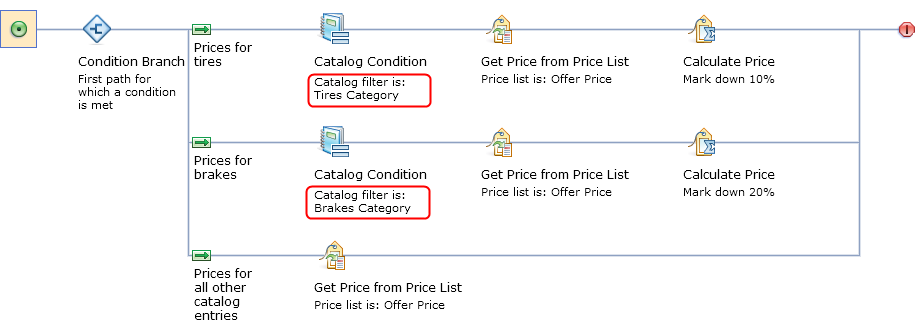

Catalog filtering
You can use the Catalog Filter and Pricing tool to filter your catalog to a specific set of catalog entries by specifying which categories, catalog entries, attribute dictionary attributes, and catalog entry properties to include or exclude from the catalog filter. Use catalog filters for your product entitlement, that is, to entitle customers to a subset of your catalog. Catalog filters can also be used as one of the price rules conditions when you are determining the prices for the set of catalog entries your customers are entitled to.
- Supports reusability across stores and contracts.
- Provides a more flexible filtering criteria that supports including or excluding by categories,
catalog entries, attributes in the attribute dictionary, and catalog entry
properties.Note: You can create catalog filters to filter objects for only your master catalog. You cannot create catalog filters for a sales catalog.
- Supports search engine-based dynamic catalog filtering, based on Solr search solution.
- Uses the Solr search framework to provide a fast and dynamic catalog filtering.
| WebSphere Commerce Accelerator Catalog Filter tool | Management Center Catalog Filter and Pricing tool |
|---|---|
| Catalog filter can be defined only within the contract model, and therefore cannot be reused across stores and contracts. | Catalog filter is independent from the contract model, and therefore can be reused across stores and contracts. |
| Lacks flexible filtering criteria because it supports including or excluding categories or SKUs only on the catalog hierarchy tree. | Flexible filtering criteria that supports including or excluding categories, catalog entries, catalog entry properties, and attribute dictionary attributes from the master catalog. |
| Filtering result is based on a prebuilt product set that is not dynamic. | Uses WebSphere Commerce search to provide fast and dynamic catalog filtering. |
Catalog filtering criteria
- Category-based criteria
- You can include or exclude categories from your catalog. If you include
a category, any catalog entry and child category under this category is
included, unless you explicitly exclude the catalog entry or category.
For example, assuming that you include the "Brake Component" parent
category in your filter, by default, all the child categories under this
category is also included; however, if you explicitly exclude the "Brake
pads" child category from the catalog filter, this child category is
excluded from the catalog.
When a category or catalog entry is included in the catalog filter, its parent categories become browsable. These automatically added parent categories allow customers to browse your site to find the explicitly included catalog entry.
- Category-based criteria with conditions
- You can apply conditions on the categories that are added to your
catalog filter. The condition can be composed of attribute dictionary
attributes or catalog entry properties. By default, the following
catalog entry properties can be specified: Product Part Number,
Manufacture Part Number, and Manufacturer Name.
To apply a condition on a certain category, you must first define a condition group. A condition group is a group of one or more attribute dictionary attributes and catalog entry properties conditions. A category can have one or more condition groups, and each condition group can contain one or more attribute dictionary attribute and property conditions. To learn more about conditions in catalog filters, see Attribute dictionary attribute and property conditions in catalog filters.
- Catalog entry-based criteria
- You can include or exclude catalog entries from your catalog. The catalog entry-based criteria takes higher precedence over the other filtering criteria. For example, assuming Product A is under Category A, if you exclude Category A and include Product A in your catalog filter, Product A is still included in the catalog filter.
Catalog filter usage: Product entitlement
Allow different customers to view and purchase different catalog entries on different stores by assigning catalog filters to contracts. When you assign catalog filters to a contract, the customers shopping under the contract can browse, search for, and purchase the catalog entries that are defined in the catalog filter. For example, in a B2B business model, you can create catalog filters, and then assign different catalog filters to each business contract. The customers shopping under the specific contract can see only the catalog entries that they are entitled to.

You can assign catalog filters to different types of contracts, for information see Catalog filter assignment and contracts.
Catalog filter usage: Price rules

Limitations
- Catalog entry properties and attribute dictionary attributes that have different values in different languages are not supported.
- For attribute dictionary attributes without predefined values, the attributes have assigned values. The attributes that require any assigned values are not supported in the filter conditions.
- Attributes that are not stored in the attribute dictionary are not supported because they are not shared by multiple catalog entries.
- Catalog filtering does not support workspaces, or content versioning.
- There is no migration tool to migrate existing catalog filters in WebSphere Commerce Accelerator to the Catalog Filter and Pricing tool.
Notes
- When you assign a catalog filter that is created in the Management Center to a contract, this catalog filter overrides any WebSphere Commerce Accelerator catalog filter.
- If you do not have a Management Center catalog filter that is assigned to the contract, the WebSphere Commerce Accelerator catalog filter is used instead.